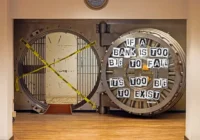As we prepared to publish this dialogue as a weekly feature in May, I addressed the following message to this dialogue’s participants:
Dear friends,
As fair observers, we have embarked on a wide open discussion about global trends concerning means of payment, currencies, trade and geopolitics. We agree that this is a transitional moment in history, in which the burning question of dedollarization is on many people’s minds. There are a lot of factors at play. As such, it requires literally thinking outside of multiple boxes.
In other words, we welcome discussion that is as open as possible, precisely because reaching a firm and convincing conclusion about the likelihood, the timing or the extent of the dethroning the dollar as the world’s reserve currency is highly unlikely. In such cases, the principle of democracy — rather than, say, “the wisdom of crowds” — requires that we share enough of our collective insights to allow even those at a great distance from the “science” to have a grasp of the way things may be trending.
Because we acknowledge this as a transitional moment of history, evidence from multiple sources tells us that dedollarization is real, if only in the sense that it’s being more and more frequently talked about. That remains true even where there is no evidence justifying the suspicion that today’s efforts at dedollarization might succeed in the kind of coup d’état some people imagine.
To place the focus on history, I submit the following representation of the trends over the past eight decades.
| The almighty dollar | 1944-1971 | Convertible to gold |
| The oil mighty dollar | 1971-2008 | Universalized by oil purchases |
| The ill mighty dollar | 2008-2025 | Quantitatively eased into fragility or irrelevance |
| The all might be dollars | 2025- | The reign of multipolar instruments of payment |
Warm regards,
Peter
************************************
I was pleased to see Ed Quince’s succinct response to this:
I like your categorization — it does outline the lifecycle of the USD as the world reserve currency very well. It also seems prudent to assume that the future will bring more choice and flexibility to the world.
Alex also approved, offering his own extended reflections.
One thing that is missing so far: we should get the “official” narrative. Of course, no official will admit that “the end for the dollar is near.” And the Europeans will have different views than the US. And, of course, the BRICS+ in turn will have even more radically different views. The hard part is to get people on the record; I assume the subject is so sensitive that nobody wants to go on the record.
But it would be great if anyone had a source that would be able to contribute anonymously. I am still searching for papers to the tune of “Reforming the International Monetary System” but wasn’t very successful. Any leads or connections at IMF, World Bank, European Central Bank, BIS, other central banks or think tanks are greatly appreciated. I am absolutely certain that discussions regarding the future of our monetary system are held among Western powers, who want to preserve the status quo, and emerging powers, who would like to change it.
The Europeans had to play their hand very carefully, being entirely dependent on the US after the destruction of their industrial base during WWII. A lot of their gold had been moved to New York, for fear of Russian invasion. The US took a dedicated path towards demonetization of gold, leaving the Federal Reserve without a single ounce of gold. But this only works if other countries follow suit; Germany had to promise the US not to purchase any gold with USD proceeds from its rising trade surplus (the “Blessing Letter”). As a “work-around,” Germany exempted purchases of gold from VAT, thereby encouraging its population to increase savings in gold. The amount of gold held by Germans is unknown, due to the decentralized and often anonymous nature of gold ownership, but according to polls Germans might own 11,000 tons (which would exceed the amount held by the US Treasury).
This might turn out to be a smart move. Why? In case of a currency crisis, the ECB would not sell its gold, but rather purchase additional gold, thereby achieving three purposes:
Afraid Germans won’t part with their gold? As frugal as Germans are, being attracted by substantial seasonal sales promotions, they sure will take advantage of a scenario where the ECB (or Bundesbank) declares “We will be bidding for gold EUR 10,000 per ounce (or any other arbitrary number) for the next two weeks only.”
The Federal Reserve does not own any gold. It had to turn over its gold to the US Treasury, receiving a non-redeemable gold “certificate,” valuing gold at $42.22 an ounce. It’s worthless. Over 80% of the Treasury’s gold is under control of the military (West Point, NY and Fort Knox, KY), underlining the importance of gold holdings for the US (despite downplaying it perpetually). You can see it here under “gold stock” (valued at $11 billion, pay attention to footnote 1).
The ECB system of central banks owns 10,792 tonnes, valued at market value. The ECB could buy or sell gold if it wanted to. The Federal Reserve cannot sell any gold since it does not own any. It probably cannot purchase any gold either, since US Code 5117 makes it unlawful to value gold at a price different from the last official price of $42.22 per ounce (for transactions among public entities). Why? Because Nixon merely ‘temporarily suspended’ gold convertibility – hence enormous amounts of gold are theoretically still owed to foreign official holders (central banks) of US dollars. The Federal Reserve would hence immediately have to recognize large write-downs on any gold purchased at market prices. But I am sure that would be their least concern in case of a currency crisis.
You can probably see how the Europeans and the Americans are set up differently to deal with a currency crisis (due to the role of gold). It is a pre-programmed collision course, and it is hard to see how an agreement would be found during a “Bretton Woods” 2.0. And we haven’t even started to include any BRICS.
The US has one ace up its sleeve: gold held by the Federal Reserve Bank of New York for “foreign official accounts” (non-US central banks, sovereign wealth funds). And it’s a lot. You can see it here under position 4, “earmarked gold.” 7.9 billion dollars, duly valued at $42.22, which comes out to 188.7 million ounces or 5,869 tons, worth around $430 billion.
The US might just choose to never return those tons to their rightful owners. What are they going to do? Invade New York? French President Georges Pompidou, pursuing his predecessor De Gaulle’s stated concerns, sent a French frigate to New York in early August 1971 to exchange dollars into gold. On August 15, Nixon closed the “gold window.” The convertibility of the dollar into gold did NOT exist for US citizens (which had been forced to hand over their private gold holdings in 1933). It existed for non-US central banks, but only as long as the bluff wasn’t called. The French called the bluff, and the game was over. But it failed to dethrone the US dollar!
Of course, a lot of conspiracy theories have spun up surrounding gold, but the above is all well documented and withstands any scrutiny. Gold, this inert stupid little metal, extracted from the earth under enormous efforts, has all but vanished from the eye of the public. But behind the scenes, the chess pieces are being moved quietly, by velvet-gloved hands, setting up the game of currencies for an epic battle.
Join the Debate
Money Matters…, is dedicated to developing this discussion and involving all interested parties.
We invite all of you who have something to contribute to send us your reflections at dialogue@fairobserver.com. We will integrate your insights into the ongoing debate. We will publish them as articles or as part of the ongoing dialogue.
Money Matters… in a Multipolar World!
*[Fair Observer’s “Crucible of Collaboration” is meant to be a space in which multiple voices can be heard, comparing and contrasting their opinions and insights in the interest of deepening and broadening our understanding of complex topics.]
[Lee Thompson-Kolar edited this piece.]
The views expressed in this article are the author’s own and do not necessarily reflect Fair Observer’s editorial policy.
Support Fair Observer
We rely on your support for our independence, diversity and quality.
For more than 10 years, Fair Observer has been free, fair and independent. No billionaire owns us, no advertisers control us. We are a reader-supported nonprofit. Unlike many other publications, we keep our content free for readers regardless of where they live or whether they can afford to pay. We have no paywalls and no ads.
In the post-truth era of fake news, echo chambers and filter bubbles, we publish a plurality of perspectives from around the world. Anyone can publish with us, but everyone goes through a rigorous editorial process. So, you get fact-checked, well-reasoned content instead of noise.
We publish 2,500+ voices from 90+ countries. We also conduct education and training programs
on subjects ranging from digital media and journalism to writing and critical thinking. This
doesn’t come cheap. Servers, editors, trainers and web developers cost
money.
Please consider supporting us on a regular basis as a recurring donor or a
sustaining member.
Will you support FO’s journalism?
We rely on your support for our independence, diversity and quality.










Comment